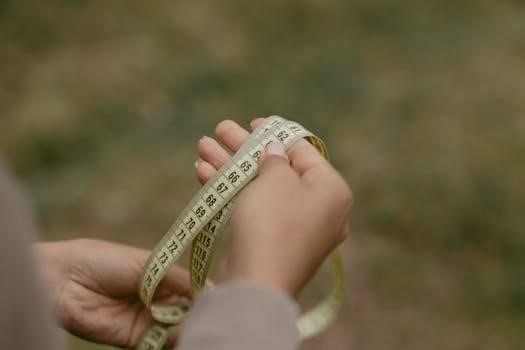Conair Weight Watchers Scale Manual⁚ A Comprehensive Guide
Welcome! This guide serves as your central resource for understanding your Conair Weight Watchers scale․ From initial setup to troubleshooting common issues, we aim to provide clear instructions and helpful tips to maximize your scale’s functionality․
Conair Weight Watchers scales are designed to assist you in monitoring your weight and achieving your health goals․ By purchasing a Weight Watchers scale, you’ve taken the first step toward taking control of your weight․ These scales offer a blend of accuracy, modern design, and user-friendly features, complementing various styles of decor․ Many models incorporate advanced technology, potentially including body analysis capabilities, which may measure body fat, water percentage, muscle mass, and bone mass․
To get the greatest benefit from your purchase, it’s essential to understand how to properly operate and maintain your scale, so carefully read the instructions․ This guide will provide a comprehensive overview, ensuring you can confidently use your scale and interpret the data it provides․

Understanding Your Conair Weight Watchers Scale Model
To fully utilize your scale, knowing your specific model is key․ Different models have varying features and instructions․ Identifying your model allows you to access the correct manual․
Identifying Your Specific Model Number
Locating your Conair Weight Watchers scale’s model number is the first step towards accessing the correct manual and understanding its specific features․ Typically, the model number is printed on a sticker located on the bottom of the scale․ Look for a combination of letters and numbers, such as “WW39” or “WWSLB11RC․” Be sure to note the entire sequence, including any spaces or dashes․
Once you have located the model number, double-check it to ensure accuracy․ A slight difference in the number can lead you to the wrong manual, causing confusion․ With the correct model number in hand, you are now ready to find the appropriate user manual online or through Conair’s website․ This ensures you have the right information for your specific scale․
Accessing the Correct Manual
After identifying your scale’s model number, accessing the correct manual is crucial for proper use and troubleshooting․ Begin by visiting the Conair website and navigating to their “Support” or “Downloads” section․ Enter your specific model number into the search bar to find the corresponding manual․ You can also try searching online using the model number followed by “user manual” or “instruction manual․”
If you cannot find the manual on the Conair website, try searching online retailers that sell Conair Weight Watchers scales․ Often, they provide links to the manuals on their product pages․ Websites like ManualsOnline or ManyManuals also host a variety of user manuals․ Once you find the manual, download it as a PDF for easy access and future reference․ Make sure the manual matches your scale’s model to avoid incorrect information․

Key Features and Functions
Understanding your Conair Weight Watchers scale’s key features is vital for accurate weight management․ This section outlines basic weighing procedures and explores advanced functionalities like body analysis, if your model supports them․
Basic Weighing Procedures
To begin, ensure your Conair Weight Watchers scale is placed on a hard, flat surface for accurate readings․ Soft surfaces like carpets can interfere with the scale’s sensors, leading to inaccurate measurements․ Before stepping on, make sure the scale is zeroed out; some models do this automatically, while others require a tap to activate․
When you step onto the scale, distribute your weight evenly and stand still․ Avoid leaning or shifting your weight during the measurement process, as this can affect the reading․ Wait for the scale to display your weight and remain steady․ Record the weight displayed for tracking purposes․
Advanced Features⁚ Body Analysis (if applicable)
Some Conair Weight Watchers scales offer advanced body analysis features, providing insights beyond just weight․ These scales use Bioelectrical Impedance Analysis (BIA) to estimate body fat percentage, body water, muscle mass, and bone mass․ To utilize these features, you’ll typically need to input personal data like age, height, and gender․
Consult your scale’s manual for specific instructions on setting up your profile․ Ensure your feet are clean and dry before stepping on the scale to ensure proper contact with the sensors․ The scale will send a harmless electrical signal through your body to measure impedance, which is then used to calculate the various body composition metrics․

Troubleshooting Common Issues
Encountering problems with your Conair Weight Watchers scale? This section addresses common issues such as the scale not turning on or displaying inaccurate readings, providing potential solutions to get you back on track․
Scale Not Turning On
If your Conair Weight Watchers scale fails to power on, the first step is to check the batteries․ Ensure they are correctly inserted and not depleted․ Replace them with fresh batteries, paying attention to the polarity (+/-) markings․ If new batteries don’t solve the issue, inspect the battery compartment for any corrosion or damage․ Gently clean the contacts with a dry cloth or cotton swab․
Confirm that the scale is placed on a hard, level surface, as uneven surfaces can sometimes interfere with the power connection․ If the problem persists, consult the user manual for specific troubleshooting steps related to your model or contact Conair customer support for assistance․
Inaccurate Readings
Inconsistent weight readings can be frustrating․ To ensure accuracy, always place your Conair Weight Watchers scale on a hard, level surface, avoiding carpets or uneven flooring․ Step onto the scale with bare feet, ensuring even weight distribution․ Avoid leaning or holding onto anything while weighing yourself․
Also, make sure the scale is set to the correct unit of measurement (pounds or kilograms)․ Fluctuations can occur due to hydration levels, so try to weigh yourself at a similar time each day․ If readings remain inaccurate, calibrate the scale according to the manual’s instructions․ If problems persist, consider replacing the batteries․

Connecting to the WW Scales by Conair App (if applicable)
If your scale is app-compatible, this section guides you through pairing it with the WW Scales by Conair app for seamless data synchronization and progress tracking․
Pairing Your Scale with the App
Begin by downloading the “WW Scales by Conair” app from the Apple App Store or Google Play Store․ Ensure Bluetooth is enabled on your smartphone or tablet․ Open the app and follow the on-screen prompts to create an account or log in if you’re an existing user․ Next, locate the “Pair Device” or similar option within the app’s settings menu․
Activate your scale by briefly stepping on it to initiate a reading․ The app should automatically detect your scale; select it from the list of available devices․ You might be prompted to enter a pairing code displayed on the scale’s screen․ Once connected, the app will confirm successful pairing, enabling data synchronization․ Should the scale time out during the setup process, simply start over․
Data Synchronization and Interpretation
After successfully pairing your Conair Weight Watchers scale with the app, data synchronization occurs automatically each time you weigh yourself․ Ensure your mobile device is within Bluetooth range of the scale during the weighing process to facilitate seamless data transfer․ Once synchronized, your weight measurements, and optionally body composition data (if applicable to your scale model), will be stored within the app․
The app then presents this information in an easily understandable format, often including charts and graphs to track progress over time․ You can view your weight trends, BMI, body fat percentage, and other metrics, depending on the scale’s capabilities․ The app allows manual entry of data if measurements were taken on another scale․ Familiarize yourself with the app’s interface to effectively interpret the data and monitor your weight management journey․